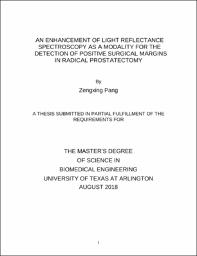
ATTENTION: The works hosted here are being migrated to a new repository that will consolidate resources, improve discoverability, and better show UTA's research impact on the global community. We will update authors as the migration progresses. Please see MavMatrix for more information.
Show simple item record
| dc.contributor.advisor | Liu, Hanli | |
| dc.creator | Pang, Zengxing | |
| dc.date.accessioned | 2019-02-27T02:02:15Z | |
| dc.date.available | 2019-02-27T02:02:15Z | |
| dc.date.created | 2018-08 | |
| dc.date.issued | 2018-08-29 | |
| dc.date.submitted | August 2018 | |
| dc.identifier.uri | http://hdl.handle.net/10106/27826 | |
| dc.description.abstract | Light Reflectance Spectroscopy (LRS) is an imaging method that has shown increasingly promising evidence in its ability to detect various forms of cancer tissues. Our previous studies have illustrated the LRS modality’s capacity to differentiate normal and cancerous prostate tissues, specifically in its effectiveness in distinguishing cancer tissues classified 4+3 and 4+4 in Gleason Score. Despite having shown sufficient sensitivity and specificity towards prostate cancer detection, the pre-existing imaging system remains impractical for its intended clinical application of detecting positive surgical margins during prostatectomy. Two of the biggest challenges in the current equipment include lack of mobility and slow data collection, which stifles LRS’s advantage of being able to stream data in real time. This is largely due to the LRS fiber optic needle being fixed by a stationary clamp and being covered by a bulky black box as shielding from spectral noise from the environment. In this study, a novel handheld device was researched and developed to overcome the inconveniencing aspects of the LRS equipment, where the needle probe was placed into a 3D printed casing and utilized in a stylus fashion. This removed the need for the aforementioned stage and box shielding, which greatly enhanced the system’s mobility. Furthermore, a tactile switch was incorporated into the 3D printed device so that data could be streamed and collected without direct interaction with computer software, thus further increasing the user-friendliness of the modality. The effectiveness of this new approach was tested against the traditional set-up, and as a result, it was discovered that the newly developed device functions optimally in low light conditions. In addition, it was discovered that the enhanced system, due to being purely handheld, contains a higher magnitude of human error that results from inconsistently applied pressure. Therefore, further studies will be required to improve the consistency new LRS device before it can be transferred into direct clinical usage. | |
| dc.format.mimetype | application/pdf | |
| dc.language.iso | en_US | |
| dc.subject | Light reflectance spectroscopy | |
| dc.subject | Radical prostatectomy | |
| dc.subject | Prostate cancer | |
| dc.subject | Positive surgical margins | |
| dc.title | An Enhancement of Light Reflectance Spectroscopy as A Modality for the Detection of Positive Surgical Margins in Radical Prostatectomy | |
| dc.type | Thesis | |
| dc.degree.department | Bioengineering | |
| dc.degree.name | Master of Science in Biomedical Engineering | |
| dc.date.updated | 2019-02-27T02:02:15Z | |
| thesis.degree.department | Bioengineering | |
| thesis.degree.grantor | The University of Texas at Arlington | |
| thesis.degree.level | Masters | |
| thesis.degree.name | Master of Science in Biomedical Engineering | |
| dc.type.material | text | |
Files in this item
- Name:
- PANG-THESIS-2018.pdf
- Size:
- 2.688Mb
- Format:
- PDF
This item appears in the following Collection(s)
Show simple item record


